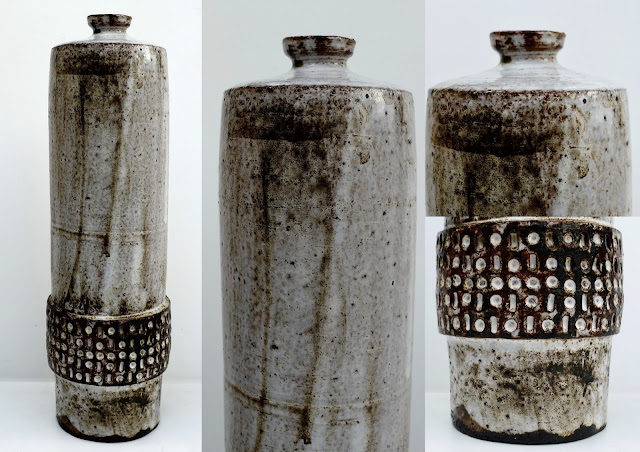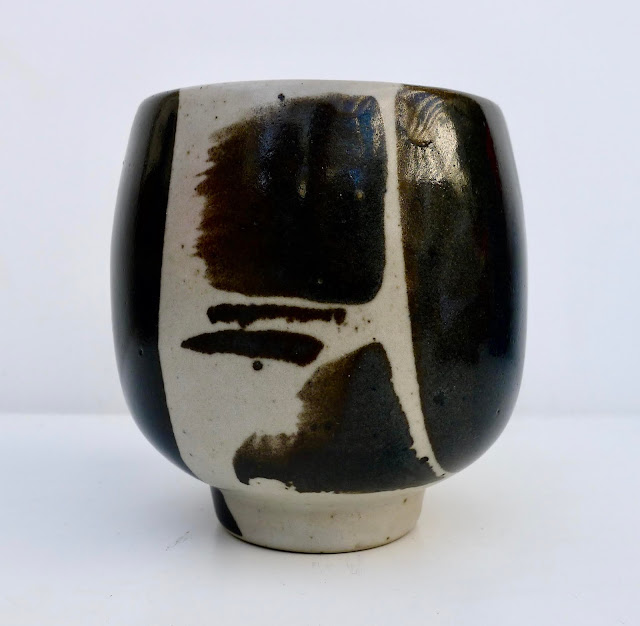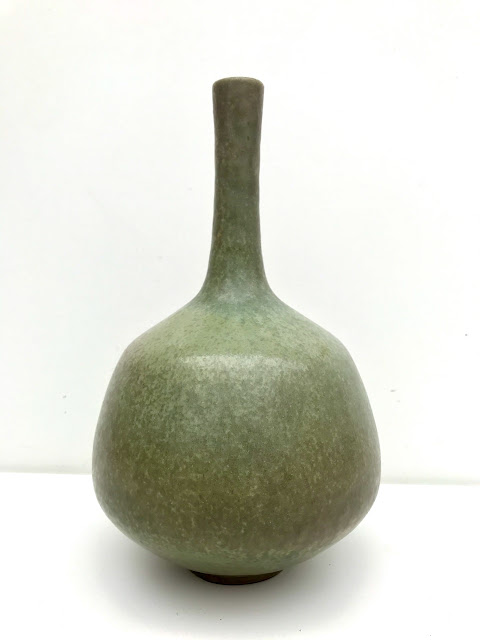A look at four jugs made between the 30s & the 50s shows a rigorous formal structuring of the vessel into its constituent part:
All four were hand-thrown; but each offers a distinctive interpretation of the jug. From left to right: an unsigned piece (inspired by traditional rural pottery), Louise Duncker, Paul Dressler, Louise Duncker.
All, however, display a touch of modernity in their interpretation of the jug. None could be described as a pastiche. Even in the most traditional artefacts one notes a touch of Modernity that infused the works.
If we look at a wider range of design spanning over the next decades we note of broadening of approaches as well as the persistence of traditional forms:
Over the same period we note a new turn in the adoption of stronger color glazes that accompany the emergence of Modern forms: either hand-turned (L to R: 1 to 4) or cast (5):
Thus, Eva Kumpman (below, left) adopts a traditional form, which she updates, and presents as a refined form (with a non-rustic glaze), whereas Wendelin Stahl transforms a hybrid form with the addition of a striking use of colour that obscure the rustic origins of the form. Although both are hand-thrown; In both the fact is under-stated, to emphasise the form and the glaze.. In so-doing, both artists avoid the trap of 'ruralism', that pervaded the rise of studio pottery in Britain (Leach, Cardew,,,):
The piece in the center by Werkstatt Werkhaus Albrecht L. Merz (Stuttgart. 50s/60s) occupies an in-between ground, where the form of the vessel is freely re-interpreted; here: with a emphatic manipulation of heavily grogged clay and a deconstruction of traditional forms also evident in the 'Constructivist' piece on the right from Steuler:
* * *
Thus, when Balzar-Kopp opted to reinterpret the tradition of German salt-glazed stoneware of the Westerwald region, she did not produce a 'pastiche', but added a modern touch that updated it, projecting it into a new ceramic present:
Her re-interpretation affects not solely the form of the jug, but also the decoration that hints at basket work (and indirectly to the origins of pottery), as well to the German tradition of incised decoration:
Here the morphology of the jug is emphasised and traditional figurative motifs have been eliminated. A new modern simplicity arises.
This is also evident in the works of Wim Muehlendyck who simplified traditional figurative motifs replacing thwm (right) with simple sgraffito patterns:
that draw from a local, centuries-old tradition which he updated:One appreciates the subtly radical transformation achieved by Balzar-Kopp in her re-interpretation of the of traditional forms :

From the 1950s (till his death in 1987), having taken over the workshop set up by his father (William Kagel Sr) in Garmish-Partenkirchen, William Kagel re-directed the family practice by producing decorative functional earthenware pieces (in which jugs predominated), in a style that continued the Bauhaus legacy (in its spirit rather than in its forms) that evoked a modern German version of the 'Art and Crafts' mouvement, decorated with restrained sgraffitoed abstract geometric motifs and uniform matt brown, green, yellow, orange and blue glazes.
What characterises these works is their formal integrity and their originality — in their modern, albeit not avant-garde, re-interpretation of tradition— and a high level of craftsmanship:
Culturally, and in terms of the history of Taste, these designs provided a symbolic link with the the German folk traditions that were vanishing: a modern version of Art & Craft.
During the 50s Rudi and Wendelin Stahl revived the stoneware tradition of the Höhr Greenzhausen region; with Wendelin switching to stoneware and deviating from rustic qualities; in particular through his use of bright colors (blue) and crystalline glazes:
From their studio 'Kießling Keramik' which they set up together in 1945, in Langenhessen (East Germany), Albert and Hildegard Kießling produced works of high quality inspired by simple forms drawn from the history of ceramics; which they decorated with a variety of glazes; initially with matt, mottled glazes in subdued natural colors:
Drawing from the knowledge acquired during his industrial training, Albert soon revealed himself as a virtuoso glazer; first launching 'snake glazes' ('schrunk glazes' in German), reminiscent of works produced in St Amand-en-Puisaye. which he revived in Germany, then developed into more dramatic and spectacularly Modern blue and white versions:Some of that tradition was continued when their daughter (who had been working at KieBling Keramik, with her mother) Gudrun Kießling married Ralf Unterstab, and they set up a studio together: 'Kunsttöpferei Unterstab'.
Together they experimented with the same concept of 'schrunk glazes' based on the overlayering of two glazes with different shrink ratios that produced cracks during cooling. The most dramatic was the sculptural cobalt colored blue and white glaze which they explored as well as crystalline blue glazes, that were also used by Walter Gebauer, Wendelin Stahl and others:

In the picture above one can follow the transformative power of glazes on ceramic forms drawn from traditions that, in some cases, went back to Antiquity. The pottery lasted till the end of the 70s, when the couple separated and the pottery closed; marking the end of a studio ceramic strand that was gradually replaced by cheaper factory productions that later were recently rediscovered and made fashionable as 'Fat Lava'.
Meanwhile, on the island of Juist, from the workshop they set up in 1949, Annemarie Schmidt-Tummely and her husband Werner produced forms and glazes of great subtlety. They also produced one-off exhibition pieces as this (below) gourde-shaped vase testifies. Here the waist of the vase has been reduced to its limits: beyond traditional Eastern and Western ceramic conventions. The result builds a subtle bridge between East and West; achieving a refined form of elegance in stoneware through a perfect collaboration between Two artists: Annemarie (form) and Werner (glaze), highlighted here by the subtle effect of the crystalline glaze:
 |
Although they produced works of high quality — both in design and craftsmanship — the pressure to increase production in order to be financially viable led potteries to batch produce run-of- the- mill 'average' domestic pieces upon which the studio depended for its survival. Unfortunately, these have flooded the market and obscure works of real quality in the mind of indiscriminating collectors who roam the car-boot sales before off-loading this tat As ‘studio pottery’ on EBay. In the best cases, however, the high level of craftsmanship achieved by the likes of Rudy Stahl led him to find his way into the national collection at British studio ceramics at Aberystwyth alongside industrially produced, but hand-crafted ceramics of quality and originality: ('Conversation' acquired by the National Archive for British Studio Ceramics at Aberystwyth).
In this 'Conversation' it confronts a factory piece from Ruscha Keramik, which, although made from a mould, shows the impact of color against the natural color of clay; albeit hand-crafted. The heavily grogged hand-thrown piece below (left), by Rudi Stahl, in another 'Conversation' asserts its austere, unglazed form, against the volcanic red and black glaze of the cast factory piece by Scheurich:
|
These two juxpossitions shows that quality can be found both in studio and in factory pieces; provided one is able to look.
Wendelin Stahl followed a different direction from that of his brother; away from the rusticity of traditional functional domestic functional objects: by using cristalline glazes over stoneware: on batch pieces that situated his work immediately in the area of decorative 'art' pottery; although some of his forms have the same rural origin a those used by his brother. Beside these, he also made one-off pieces for the Art market; for which he achieved recognition.
Elke and Elmar Kubicek continued the earthenware tradition with pieces which bore the influence of traditional Japanese stoneware; at a time where it was being discovered in Germany:
Elke and Elmar Kubicek, Vase, hand-thrown earthenware, decorated with splashed abstract matt bordeaux and brown glaze.
From the studio he set up in Bremen, in 1949, Gerhard Liebenthron produced a variety of forms in stoneware, which he decorated either with his distinctive, fluid abstract calligraphic brush work or with rich single color (blue, green; matt or gloss, etc.). Like many of his contemporaries, he also experimented with crystalline glazes. Across his work one recognises — above and in the large pot below — a strong Japanese influence:


One feature of German ceramics of the post-war years was it drawing forms and designs from archaeological museums.
However, this 1967 large vase (below), in Brutalist style, re-interprets the form of the vase in contemporary architectural terms — with its emphasis on MASS and in its frieze-like concrete relief ornamentation on the lower part — which it combines with subtle brush-work associated with Chinese or Japanese calligraphy. The outcome is a rather extra-ordinary piece (not solely in Liebenthron's oeuvre); that shows a radical shift whereby vases began to escape from the condition of 'pot', and aspired towards the condition of sculpture and architecture:
From the late 60s to the 80s and beyond and a new type of works emerged, in stoneware, that departed from the 'earthy' style of previous generations. Although hand-thrown, the these works merely hinted at the fact; prefering to emphasise the form and very accomplished glazes.
From left to right: Gerhard Liebenthron, Rolf Weber, Horst Kerstan, Barbara Stehr (x2)
Zenker-Karthausen:

in which the vase displays the traces of the hand left during throwing as part of its aesthetics.
By contrast Heidi Kippenberg produced works that did not emphasise the traces of the hands; but present us with 'platonic' forms that seem to have risen from a world of pure Forms, transcending the material it is made of:
This tendency is evident in the works of Rolf Weber:
Barbara Stehr:
As the two following vases shows — the first by Elizabeth Pluquet-Ulrich — works that were made in the tradition that had grown from the potter's wheel, served as the formative stage for future experiments.
Christel Humpert (in Bochum) followed this tradition to produce both refined single personal pieces as well as coarse, mass-produced domestic objects:
Buyers of her work should not expect to pay the same price for both types of works.
It is surprising, perhaps, to find that standards techniques of hand-throwing were also used to generate sculptural forms such as the one below by the Kuch studio, inspired by contemporary sculpture:
It confirms that the potter’s wheel stands at the heart of German ceramics of the post war years/decades - even factory production - as it set a model to produce clay forms which either emphasise it or made it invisible.
FACTORY-PRODUCED CERAMICS WITH ARTISTIC AMBITIONS
(Bauhaus strand 2).
THE DEVELOPMENT OF SERIAL PRODUCTION
The second Bauhaus principle that advocated the production of designs intended for serial production was taken up by several German firms as early as the 1930s.
Thus, for instance, the Staatliche Majolika-Manufaktur in Karslruhe instigated, through the collaboration of Martha Katzer and Gerda Conitz, the production of a decorative ceramics of high quality:
In 1935 WMF (then known for their metal work and decorative glass) started to manufacture decorative ceramics. To help them in their task, they called on Gerda Conitz as art director. The vase below, was produced as part of this new IKORA ceramic range:
Conitz's contribution is evident in the forms as well as in the glazes she designed, Many used on this vase were inspired by Chinese 'sang- de-boeuf' glazes.
(WMF ceased ceramic production in 1949).
The Chinese influence continued to be felt; as in the vase below, designed by Greta Schulte-Hostedde in 1956 for Staatliche Majolika-Manufaktur:
with a glaze designed by Conitz.
The three vases (below) shows the range of forms and glazes — and the high standards — achieved at the Staatliche Majolika-Manufaktur:
The Chinese influence lasted well into the 70s.
It is manifest — albeit in a modern interpretation — in a series of porcelain vases designed by Renée Neue the for the traditional porcelain manufacture Hutschenruther. In addition to these, Neue produced designs that span from updated historical forms (below):
to contemporary, Pop Art style; below in a work reminiscent of Jasper Johns's earlier target paintings from the mid 50s.
::

Alongside other porcelain manufacturers, Hustchenruther also produced a range of white porcelain vases that departed from traditional forms.
KPM who had produced (and never stopped making) Bauhaus designs by Marguerite Friedlaender in white porcelain, added radically new designs that introduced layers of glazes in bright colors:
Several other German firms imitated this range. It was popularised as Sgrafo in pioneer collector and art critic Nicolas Trembley, in his book Sgrafo vs Fat Lava (2011).
or
biomorphic:These works have been reivived and publicized under the label 'Sgrafo' by collector-art critic Nicolas Trembley in his book Sgrafo vs Fat Lava (2011).
REMARKS on QUALITY & PRICING:
It is important, for the serious collector, to be able to distinguish between 'good' , 'outstanding' and 'mediocre' works; especially when produced in the same studio or workshop; and, secondly, not to conflate mechanical, mass-produced, factory-made objects with artistically crafted individual studio pieces.
The recent craze and fashion for 'West German Ceramics', promoted as 'FAT LAVA' (often improperly referred to as 'studio pottery'), seems to have corrupted the taste of 'magpie collectors', who forego critical faculties in order to revel into a collecting + trading practices of often mediocre objects.
Collectors beware! And seek out the best.
The works I am offering for sale on Ebay represent the best of each individual artist — whether studio of factory pieces — chosen for their aesthetic quality and their historical significance.
Many were included in the exhibition KERAMIK CONVERSATIONS that I curated for the Archives for Contemporary British Studio Ceramics at Aberystwyth.
On-line catalogue available free at: http://keramicconversations.blogspot.com/
This blog was created to contextualise the works for sale and to help visitors find their way.
Wishing you a enjoyable exploration!
(TO BE CONTINUED).








































Comments
Post a Comment